Analysis of Nestle Plc's Employee Recruitment, Selection, and Training
VerifiedAdded on 2021/02/22
|24
|4662
|255
Report
AI Summary
This report examines Nestle Plc's recruitment, selection, and training processes in the context of globalization. The research background highlights the impact of globalization on business operations and the need for multinational companies like Nestle to adapt their HR practices. The report explores the aims and objectives of the study, including understanding current recruitment and training processes, identifying necessary improvements to meet international standards, and addressing challenges related to labor migration. The project management plan outlines the scope, cost, time, communication, and risk factors involved. The research methodology employs a qualitative approach, using questionnaires administered to HR managers at Nestle Plc. The data analysis reveals key themes, including uncertainty among managers regarding current processes, agreement on the need for change, and suggestions for improvements. The findings highlight the challenges faced by Nestle in its recruitment and training processes, specifically language barriers. The report concludes with recommendations for enhancing training processes to address these challenges and meet international standards. This report provides a comprehensive analysis of Nestle's HR strategies, offering valuable insights into the complexities of global recruitment and training.
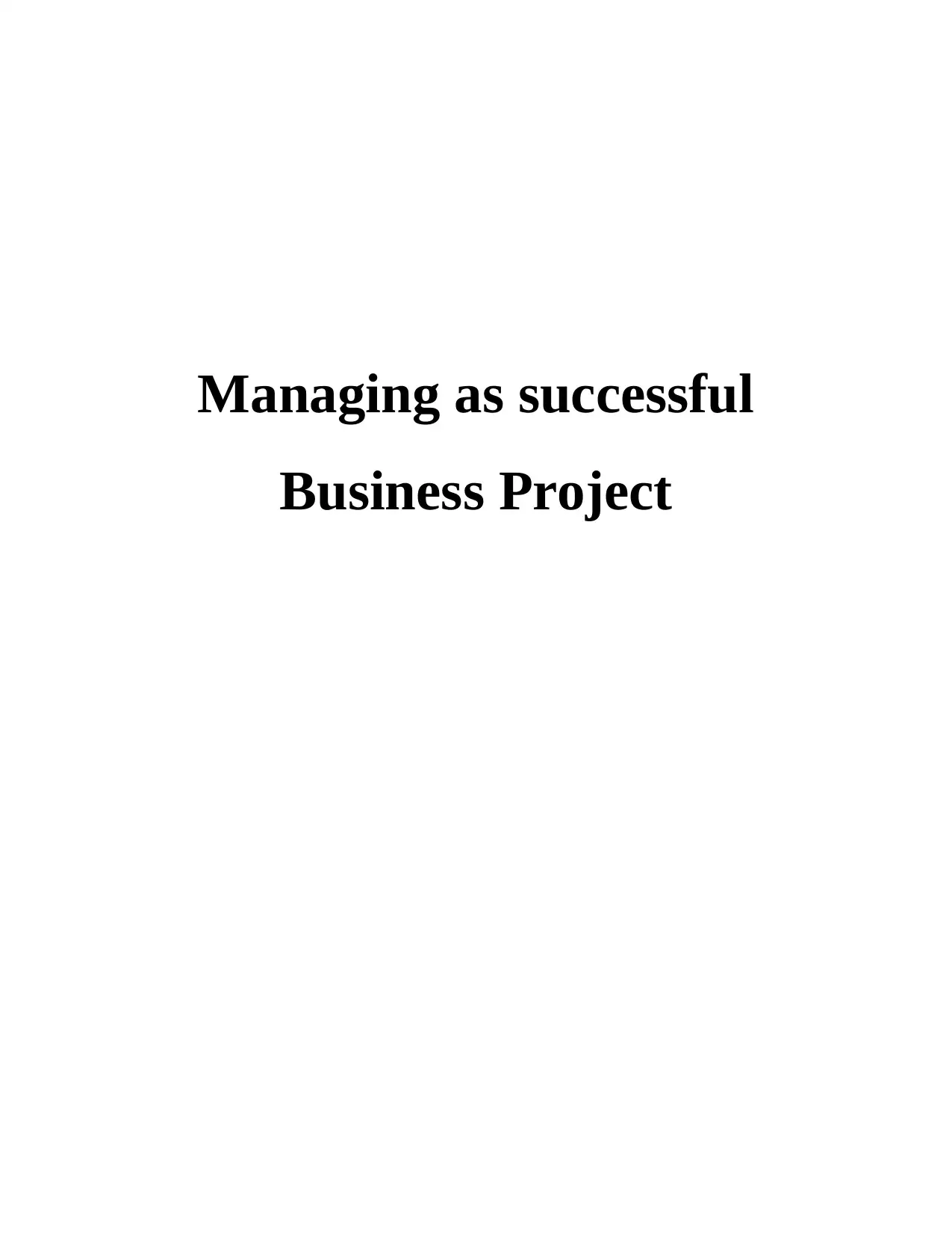
Managing as successful
Business Project
Business Project
Paraphrase This Document
Need a fresh take? Get an instant paraphrase of this document with our AI Paraphraser

Table of Contents
TOPIC:.............................................................................................................................................3
INTRODUCTION...........................................................................................................................3
Research Background.............................................................................................................3
Rationale.................................................................................................................................3
LO 1.................................................................................................................................................3
Aims and Objectives..............................................................................................................3
Project Management Plan.......................................................................................................4
Time Scale, Gantt chart..........................................................................................................5
LO 2.................................................................................................................................................8
Research Methodology...........................................................................................................8
LO.3.................................................................................................................................................9
Data Analyse and Interpretation.............................................................................................9
Recommendation..................................................................................................................16
LO 4...............................................................................................................................................17
Reflection.............................................................................................................................17
CONCLUSION..............................................................................................................................17
REFERENCES..............................................................................................................................18
Appendix........................................................................................................................................19
Log Book..............................................................................................................................20
Performance Review template..............................................................................................23
TOPIC:.............................................................................................................................................3
INTRODUCTION...........................................................................................................................3
Research Background.............................................................................................................3
Rationale.................................................................................................................................3
LO 1.................................................................................................................................................3
Aims and Objectives..............................................................................................................3
Project Management Plan.......................................................................................................4
Time Scale, Gantt chart..........................................................................................................5
LO 2.................................................................................................................................................8
Research Methodology...........................................................................................................8
LO.3.................................................................................................................................................9
Data Analyse and Interpretation.............................................................................................9
Recommendation..................................................................................................................16
LO 4...............................................................................................................................................17
Reflection.............................................................................................................................17
CONCLUSION..............................................................................................................................17
REFERENCES..............................................................................................................................18
Appendix........................................................................................................................................19
Log Book..............................................................................................................................20
Performance Review template..............................................................................................23

TOPIC:
“How do multinational companies improve the recruitment, selection and training of
their employees to meet International requirements?”
INTRODUCTION
Research Background.
Globalization is the main component that has led to the revolution change in the business
operations through its activities like cross border trade, exchange of information and technology,
movement of people across the world and other economic factors like exchange of currency etc.
It has lead to the autonomous movement of goods and services and people across different
countries and has affected various functions of business like-marketing, HR, Operations and
finance. This project report is based on the study of Nestle Plc, which is the largest FMCG
company and deals in packed foods, chocolates and dairy products. The company has its
operations in 194 countries across the world. Nestle has around 450 factories and consists
339,000 employees working for it across the world. This project report will highlight the process
of recruitment and selection and employees training of Nestle Plc and the improvements to gbe
made in order to cope up with the globalization trends and meet up international standards.
Rationale
The intent for this topic selection by the researchers is to understand the recruitment
selection and training process of the multinational organization and to understand what
improvements can be made in these processes to meet up the international standards in context
with globalization. On the flip side another purpose for this project preparation is for the
academic requirements of the researcher.
“How do multinational companies improve the recruitment, selection and training of
their employees to meet International requirements?”
INTRODUCTION
Research Background.
Globalization is the main component that has led to the revolution change in the business
operations through its activities like cross border trade, exchange of information and technology,
movement of people across the world and other economic factors like exchange of currency etc.
It has lead to the autonomous movement of goods and services and people across different
countries and has affected various functions of business like-marketing, HR, Operations and
finance. This project report is based on the study of Nestle Plc, which is the largest FMCG
company and deals in packed foods, chocolates and dairy products. The company has its
operations in 194 countries across the world. Nestle has around 450 factories and consists
339,000 employees working for it across the world. This project report will highlight the process
of recruitment and selection and employees training of Nestle Plc and the improvements to gbe
made in order to cope up with the globalization trends and meet up international standards.
Rationale
The intent for this topic selection by the researchers is to understand the recruitment
selection and training process of the multinational organization and to understand what
improvements can be made in these processes to meet up the international standards in context
with globalization. On the flip side another purpose for this project preparation is for the
academic requirements of the researcher.
⊘ This is a preview!⊘
Do you want full access?
Subscribe today to unlock all pages.

Trusted by 1+ million students worldwide
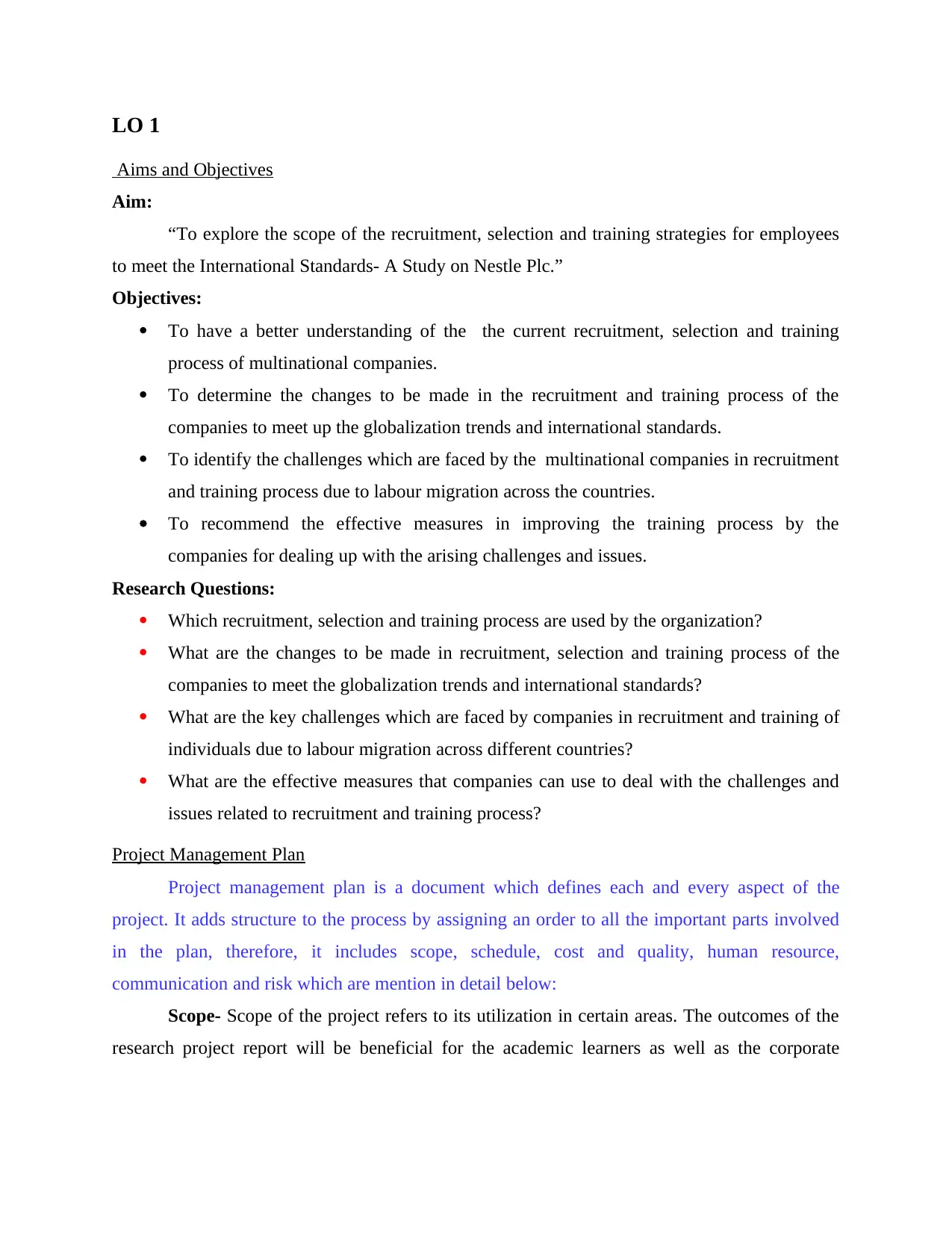
LO 1
Aims and Objectives
Aim:
“To explore the scope of the recruitment, selection and training strategies for employees
to meet the International Standards- A Study on Nestle Plc.”
Objectives:
To have a better understanding of the the current recruitment, selection and training
process of multinational companies.
To determine the changes to be made in the recruitment and training process of the
companies to meet up the globalization trends and international standards.
To identify the challenges which are faced by the multinational companies in recruitment
and training process due to labour migration across the countries.
To recommend the effective measures in improving the training process by the
companies for dealing up with the arising challenges and issues.
Research Questions:
Which recruitment, selection and training process are used by the organization?
What are the changes to be made in recruitment, selection and training process of the
companies to meet the globalization trends and international standards?
What are the key challenges which are faced by companies in recruitment and training of
individuals due to labour migration across different countries?
What are the effective measures that companies can use to deal with the challenges and
issues related to recruitment and training process?
Project Management Plan
Project management plan is a document which defines each and every aspect of the
project. It adds structure to the process by assigning an order to all the important parts involved
in the plan, therefore, it includes scope, schedule, cost and quality, human resource,
communication and risk which are mention in detail below:
Scope- Scope of the project refers to its utilization in certain areas. The outcomes of the
research project report will be beneficial for the academic learners as well as the corporate
Aims and Objectives
Aim:
“To explore the scope of the recruitment, selection and training strategies for employees
to meet the International Standards- A Study on Nestle Plc.”
Objectives:
To have a better understanding of the the current recruitment, selection and training
process of multinational companies.
To determine the changes to be made in the recruitment and training process of the
companies to meet up the globalization trends and international standards.
To identify the challenges which are faced by the multinational companies in recruitment
and training process due to labour migration across the countries.
To recommend the effective measures in improving the training process by the
companies for dealing up with the arising challenges and issues.
Research Questions:
Which recruitment, selection and training process are used by the organization?
What are the changes to be made in recruitment, selection and training process of the
companies to meet the globalization trends and international standards?
What are the key challenges which are faced by companies in recruitment and training of
individuals due to labour migration across different countries?
What are the effective measures that companies can use to deal with the challenges and
issues related to recruitment and training process?
Project Management Plan
Project management plan is a document which defines each and every aspect of the
project. It adds structure to the process by assigning an order to all the important parts involved
in the plan, therefore, it includes scope, schedule, cost and quality, human resource,
communication and risk which are mention in detail below:
Scope- Scope of the project refers to its utilization in certain areas. The outcomes of the
research project report will be beneficial for the academic learners as well as the corporate
Paraphrase This Document
Need a fresh take? Get an instant paraphrase of this document with our AI Paraphraser
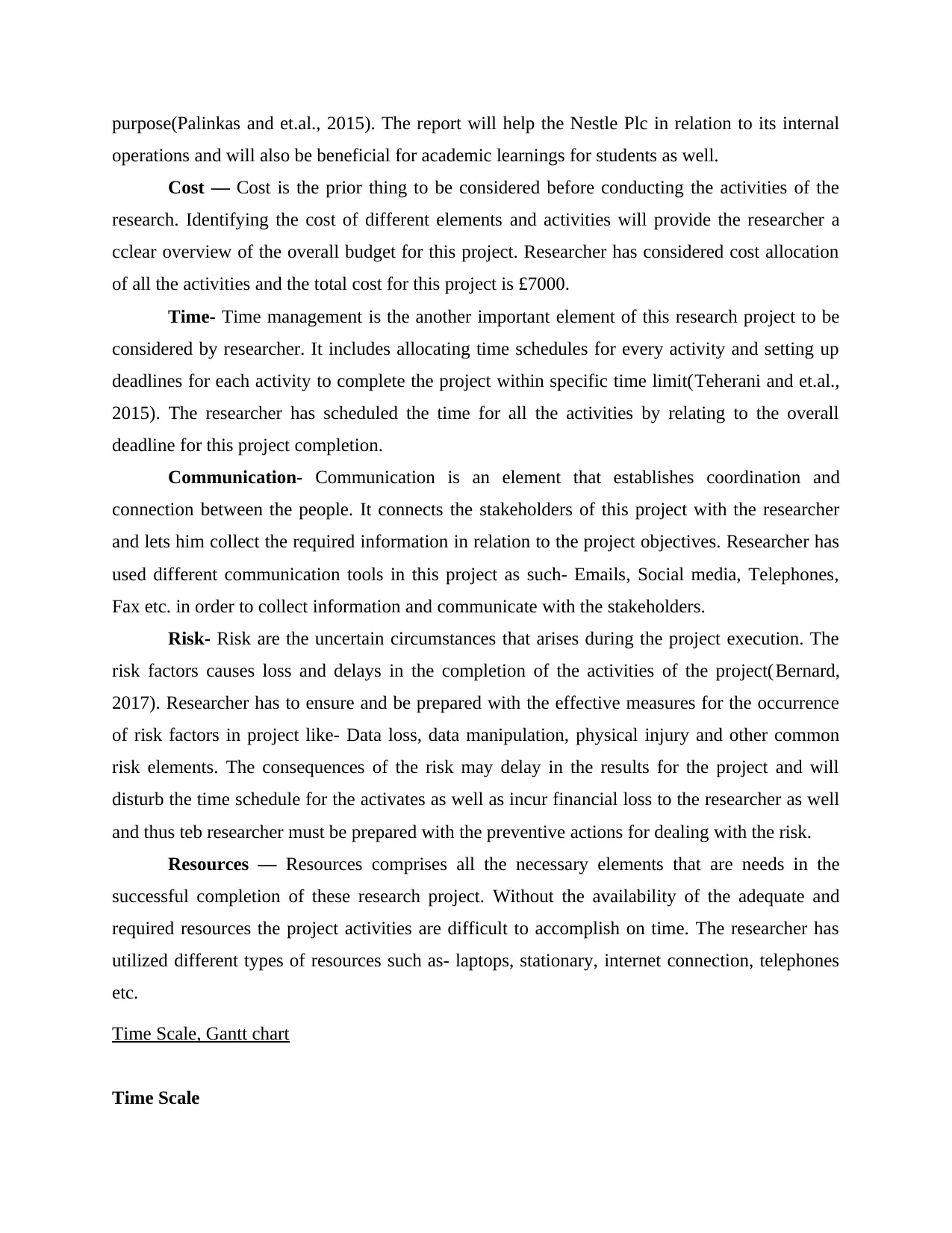
purpose(Palinkas and et.al., 2015). The report will help the Nestle Plc in relation to its internal
operations and will also be beneficial for academic learnings for students as well.
Cost — Cost is the prior thing to be considered before conducting the activities of the
research. Identifying the cost of different elements and activities will provide the researcher a
cclear overview of the overall budget for this project. Researcher has considered cost allocation
of all the activities and the total cost for this project is £7000.
Time- Time management is the another important element of this research project to be
considered by researcher. It includes allocating time schedules for every activity and setting up
deadlines for each activity to complete the project within specific time limit(Teherani and et.al.,
2015). The researcher has scheduled the time for all the activities by relating to the overall
deadline for this project completion.
Communication- Communication is an element that establishes coordination and
connection between the people. It connects the stakeholders of this project with the researcher
and lets him collect the required information in relation to the project objectives. Researcher has
used different communication tools in this project as such- Emails, Social media, Telephones,
Fax etc. in order to collect information and communicate with the stakeholders.
Risk- Risk are the uncertain circumstances that arises during the project execution. The
risk factors causes loss and delays in the completion of the activities of the project(Bernard,
2017). Researcher has to ensure and be prepared with the effective measures for the occurrence
of risk factors in project like- Data loss, data manipulation, physical injury and other common
risk elements. The consequences of the risk may delay in the results for the project and will
disturb the time schedule for the activates as well as incur financial loss to the researcher as well
and thus teb researcher must be prepared with the preventive actions for dealing with the risk.
Resources — Resources comprises all the necessary elements that are needs in the
successful completion of these research project. Without the availability of the adequate and
required resources the project activities are difficult to accomplish on time. The researcher has
utilized different types of resources such as- laptops, stationary, internet connection, telephones
etc.
Time Scale, Gantt chart
Time Scale
operations and will also be beneficial for academic learnings for students as well.
Cost — Cost is the prior thing to be considered before conducting the activities of the
research. Identifying the cost of different elements and activities will provide the researcher a
cclear overview of the overall budget for this project. Researcher has considered cost allocation
of all the activities and the total cost for this project is £7000.
Time- Time management is the another important element of this research project to be
considered by researcher. It includes allocating time schedules for every activity and setting up
deadlines for each activity to complete the project within specific time limit(Teherani and et.al.,
2015). The researcher has scheduled the time for all the activities by relating to the overall
deadline for this project completion.
Communication- Communication is an element that establishes coordination and
connection between the people. It connects the stakeholders of this project with the researcher
and lets him collect the required information in relation to the project objectives. Researcher has
used different communication tools in this project as such- Emails, Social media, Telephones,
Fax etc. in order to collect information and communicate with the stakeholders.
Risk- Risk are the uncertain circumstances that arises during the project execution. The
risk factors causes loss and delays in the completion of the activities of the project(Bernard,
2017). Researcher has to ensure and be prepared with the effective measures for the occurrence
of risk factors in project like- Data loss, data manipulation, physical injury and other common
risk elements. The consequences of the risk may delay in the results for the project and will
disturb the time schedule for the activates as well as incur financial loss to the researcher as well
and thus teb researcher must be prepared with the preventive actions for dealing with the risk.
Resources — Resources comprises all the necessary elements that are needs in the
successful completion of these research project. Without the availability of the adequate and
required resources the project activities are difficult to accomplish on time. The researcher has
utilized different types of resources such as- laptops, stationary, internet connection, telephones
etc.
Time Scale, Gantt chart
Time Scale

⊘ This is a preview!⊘
Do you want full access?
Subscribe today to unlock all pages.

Trusted by 1+ million students worldwide
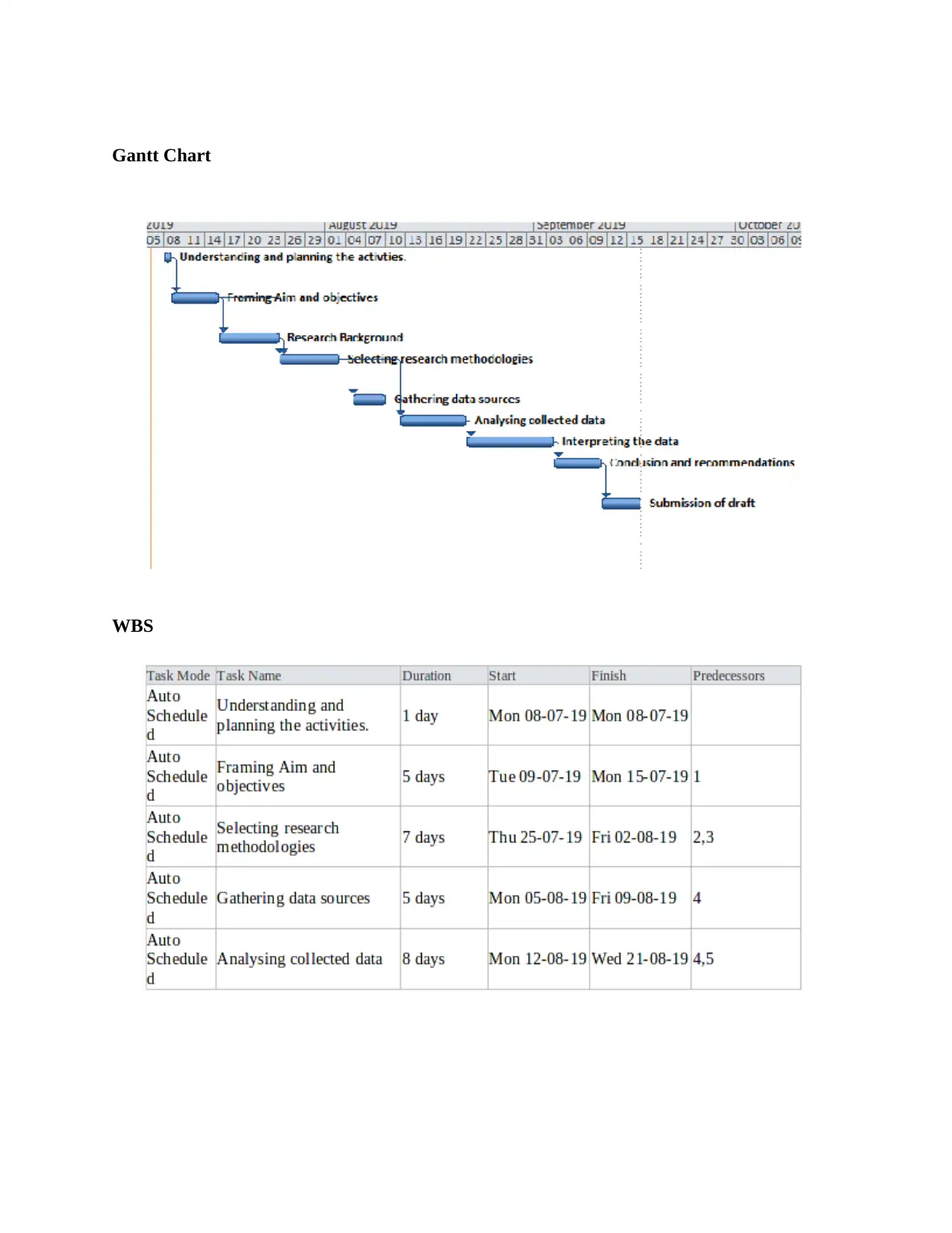
Gantt Chart
WBS
WBS
Paraphrase This Document
Need a fresh take? Get an instant paraphrase of this document with our AI Paraphraser
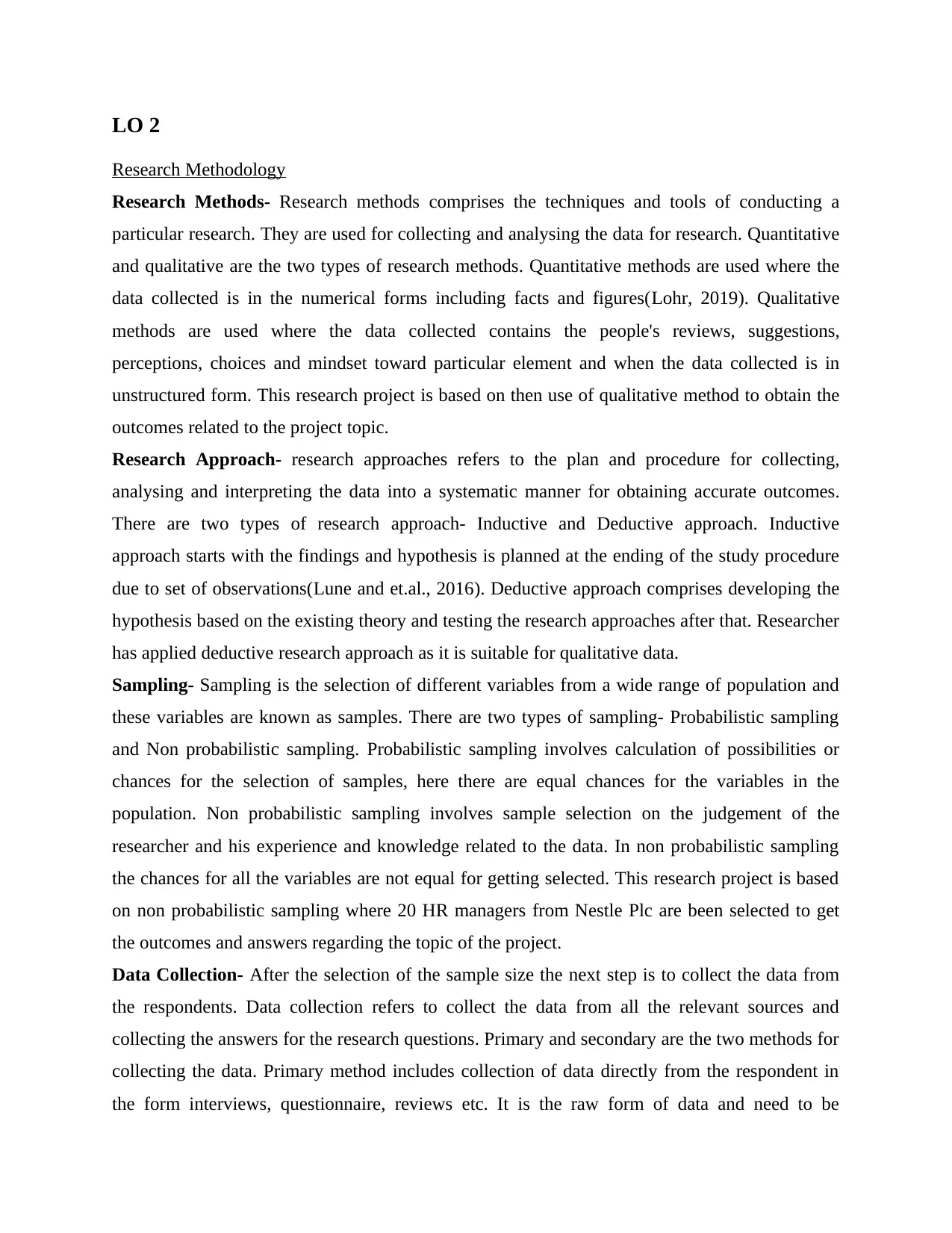
LO 2
Research Methodology
Research Methods- Research methods comprises the techniques and tools of conducting a
particular research. They are used for collecting and analysing the data for research. Quantitative
and qualitative are the two types of research methods. Quantitative methods are used where the
data collected is in the numerical forms including facts and figures(Lohr, 2019). Qualitative
methods are used where the data collected contains the people's reviews, suggestions,
perceptions, choices and mindset toward particular element and when the data collected is in
unstructured form. This research project is based on then use of qualitative method to obtain the
outcomes related to the project topic.
Research Approach- research approaches refers to the plan and procedure for collecting,
analysing and interpreting the data into a systematic manner for obtaining accurate outcomes.
There are two types of research approach- Inductive and Deductive approach. Inductive
approach starts with the findings and hypothesis is planned at the ending of the study procedure
due to set of observations(Lune and et.al., 2016). Deductive approach comprises developing the
hypothesis based on the existing theory and testing the research approaches after that. Researcher
has applied deductive research approach as it is suitable for qualitative data.
Sampling- Sampling is the selection of different variables from a wide range of population and
these variables are known as samples. There are two types of sampling- Probabilistic sampling
and Non probabilistic sampling. Probabilistic sampling involves calculation of possibilities or
chances for the selection of samples, here there are equal chances for the variables in the
population. Non probabilistic sampling involves sample selection on the judgement of the
researcher and his experience and knowledge related to the data. In non probabilistic sampling
the chances for all the variables are not equal for getting selected. This research project is based
on non probabilistic sampling where 20 HR managers from Nestle Plc are been selected to get
the outcomes and answers regarding the topic of the project.
Data Collection- After the selection of the sample size the next step is to collect the data from
the respondents. Data collection refers to collect the data from all the relevant sources and
collecting the answers for the research questions. Primary and secondary are the two methods for
collecting the data. Primary method includes collection of data directly from the respondent in
the form interviews, questionnaire, reviews etc. It is the raw form of data and need to be
Research Methodology
Research Methods- Research methods comprises the techniques and tools of conducting a
particular research. They are used for collecting and analysing the data for research. Quantitative
and qualitative are the two types of research methods. Quantitative methods are used where the
data collected is in the numerical forms including facts and figures(Lohr, 2019). Qualitative
methods are used where the data collected contains the people's reviews, suggestions,
perceptions, choices and mindset toward particular element and when the data collected is in
unstructured form. This research project is based on then use of qualitative method to obtain the
outcomes related to the project topic.
Research Approach- research approaches refers to the plan and procedure for collecting,
analysing and interpreting the data into a systematic manner for obtaining accurate outcomes.
There are two types of research approach- Inductive and Deductive approach. Inductive
approach starts with the findings and hypothesis is planned at the ending of the study procedure
due to set of observations(Lune and et.al., 2016). Deductive approach comprises developing the
hypothesis based on the existing theory and testing the research approaches after that. Researcher
has applied deductive research approach as it is suitable for qualitative data.
Sampling- Sampling is the selection of different variables from a wide range of population and
these variables are known as samples. There are two types of sampling- Probabilistic sampling
and Non probabilistic sampling. Probabilistic sampling involves calculation of possibilities or
chances for the selection of samples, here there are equal chances for the variables in the
population. Non probabilistic sampling involves sample selection on the judgement of the
researcher and his experience and knowledge related to the data. In non probabilistic sampling
the chances for all the variables are not equal for getting selected. This research project is based
on non probabilistic sampling where 20 HR managers from Nestle Plc are been selected to get
the outcomes and answers regarding the topic of the project.
Data Collection- After the selection of the sample size the next step is to collect the data from
the respondents. Data collection refers to collect the data from all the relevant sources and
collecting the answers for the research questions. Primary and secondary are the two methods for
collecting the data. Primary method includes collection of data directly from the respondent in
the form interviews, questionnaire, reviews etc. It is the raw form of data and need to be
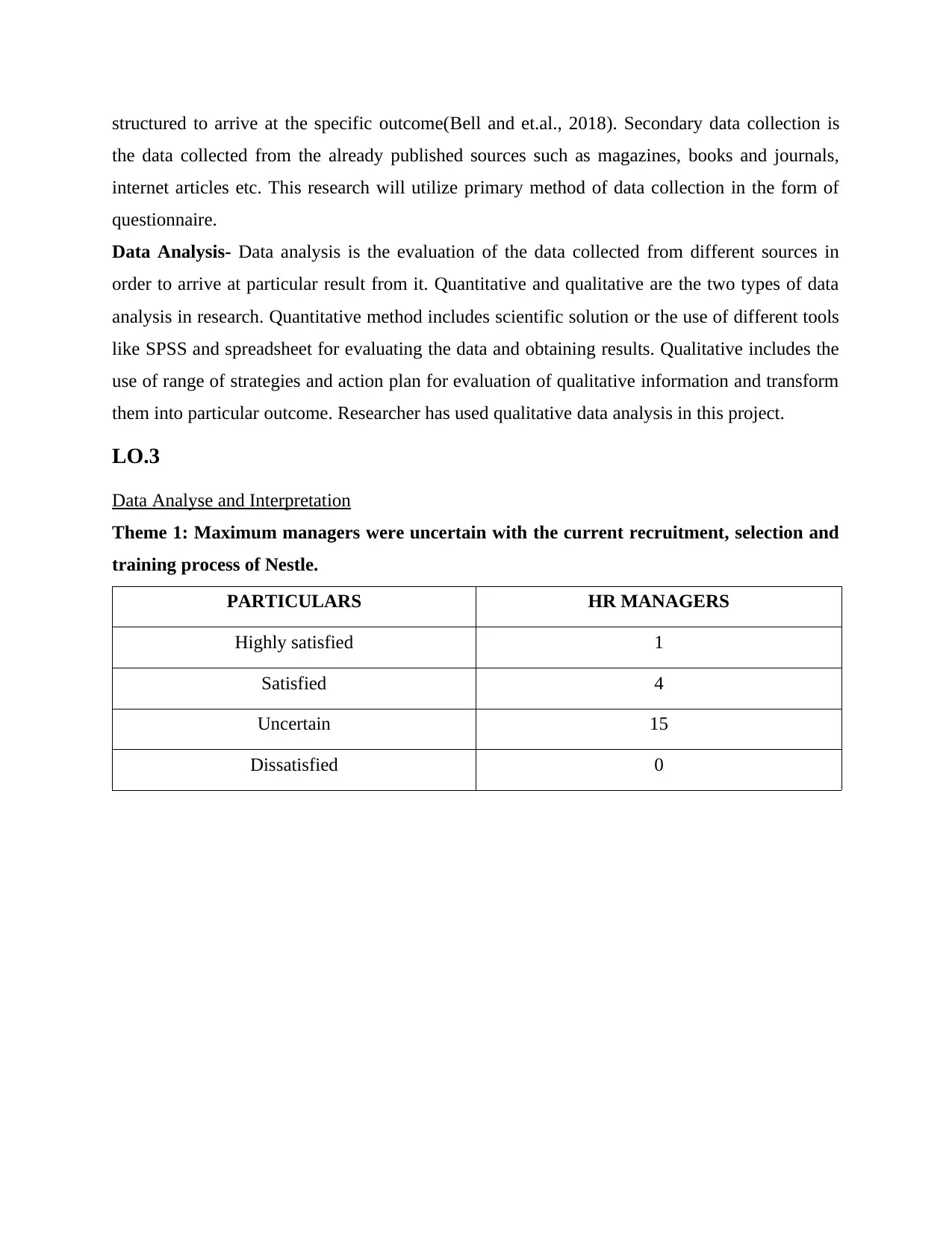
structured to arrive at the specific outcome(Bell and et.al., 2018). Secondary data collection is
the data collected from the already published sources such as magazines, books and journals,
internet articles etc. This research will utilize primary method of data collection in the form of
questionnaire.
Data Analysis- Data analysis is the evaluation of the data collected from different sources in
order to arrive at particular result from it. Quantitative and qualitative are the two types of data
analysis in research. Quantitative method includes scientific solution or the use of different tools
like SPSS and spreadsheet for evaluating the data and obtaining results. Qualitative includes the
use of range of strategies and action plan for evaluation of qualitative information and transform
them into particular outcome. Researcher has used qualitative data analysis in this project.
LO.3
Data Analyse and Interpretation
Theme 1: Maximum managers were uncertain with the current recruitment, selection and
training process of Nestle.
PARTICULARS HR MANAGERS
Highly satisfied 1
Satisfied 4
Uncertain 15
Dissatisfied 0
the data collected from the already published sources such as magazines, books and journals,
internet articles etc. This research will utilize primary method of data collection in the form of
questionnaire.
Data Analysis- Data analysis is the evaluation of the data collected from different sources in
order to arrive at particular result from it. Quantitative and qualitative are the two types of data
analysis in research. Quantitative method includes scientific solution or the use of different tools
like SPSS and spreadsheet for evaluating the data and obtaining results. Qualitative includes the
use of range of strategies and action plan for evaluation of qualitative information and transform
them into particular outcome. Researcher has used qualitative data analysis in this project.
LO.3
Data Analyse and Interpretation
Theme 1: Maximum managers were uncertain with the current recruitment, selection and
training process of Nestle.
PARTICULARS HR MANAGERS
Highly satisfied 1
Satisfied 4
Uncertain 15
Dissatisfied 0
⊘ This is a preview!⊘
Do you want full access?
Subscribe today to unlock all pages.

Trusted by 1+ million students worldwide
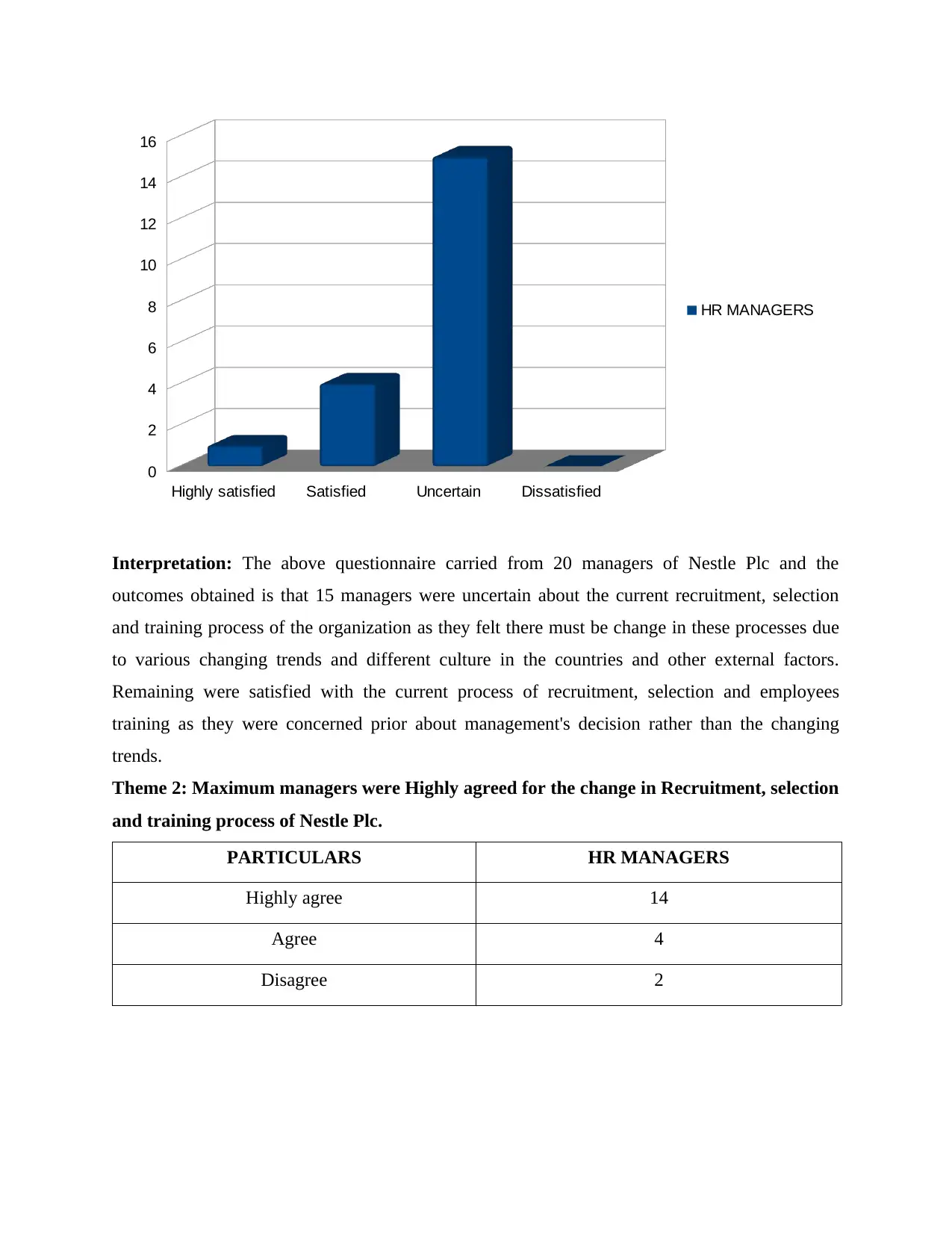
Interpretation: The above questionnaire carried from 20 managers of Nestle Plc and the
outcomes obtained is that 15 managers were uncertain about the current recruitment, selection
and training process of the organization as they felt there must be change in these processes due
to various changing trends and different culture in the countries and other external factors.
Remaining were satisfied with the current process of recruitment, selection and employees
training as they were concerned prior about management's decision rather than the changing
trends.
Theme 2: Maximum managers were Highly agreed for the change in Recruitment, selection
and training process of Nestle Plc.
PARTICULARS HR MANAGERS
Highly agree 14
Agree 4
Disagree 2
Highly satisfied Satisfied Uncertain Dissatisfied
0
2
4
6
8
10
12
14
16
HR MANAGERS
outcomes obtained is that 15 managers were uncertain about the current recruitment, selection
and training process of the organization as they felt there must be change in these processes due
to various changing trends and different culture in the countries and other external factors.
Remaining were satisfied with the current process of recruitment, selection and employees
training as they were concerned prior about management's decision rather than the changing
trends.
Theme 2: Maximum managers were Highly agreed for the change in Recruitment, selection
and training process of Nestle Plc.
PARTICULARS HR MANAGERS
Highly agree 14
Agree 4
Disagree 2
Highly satisfied Satisfied Uncertain Dissatisfied
0
2
4
6
8
10
12
14
16
HR MANAGERS
Paraphrase This Document
Need a fresh take? Get an instant paraphrase of this document with our AI Paraphraser
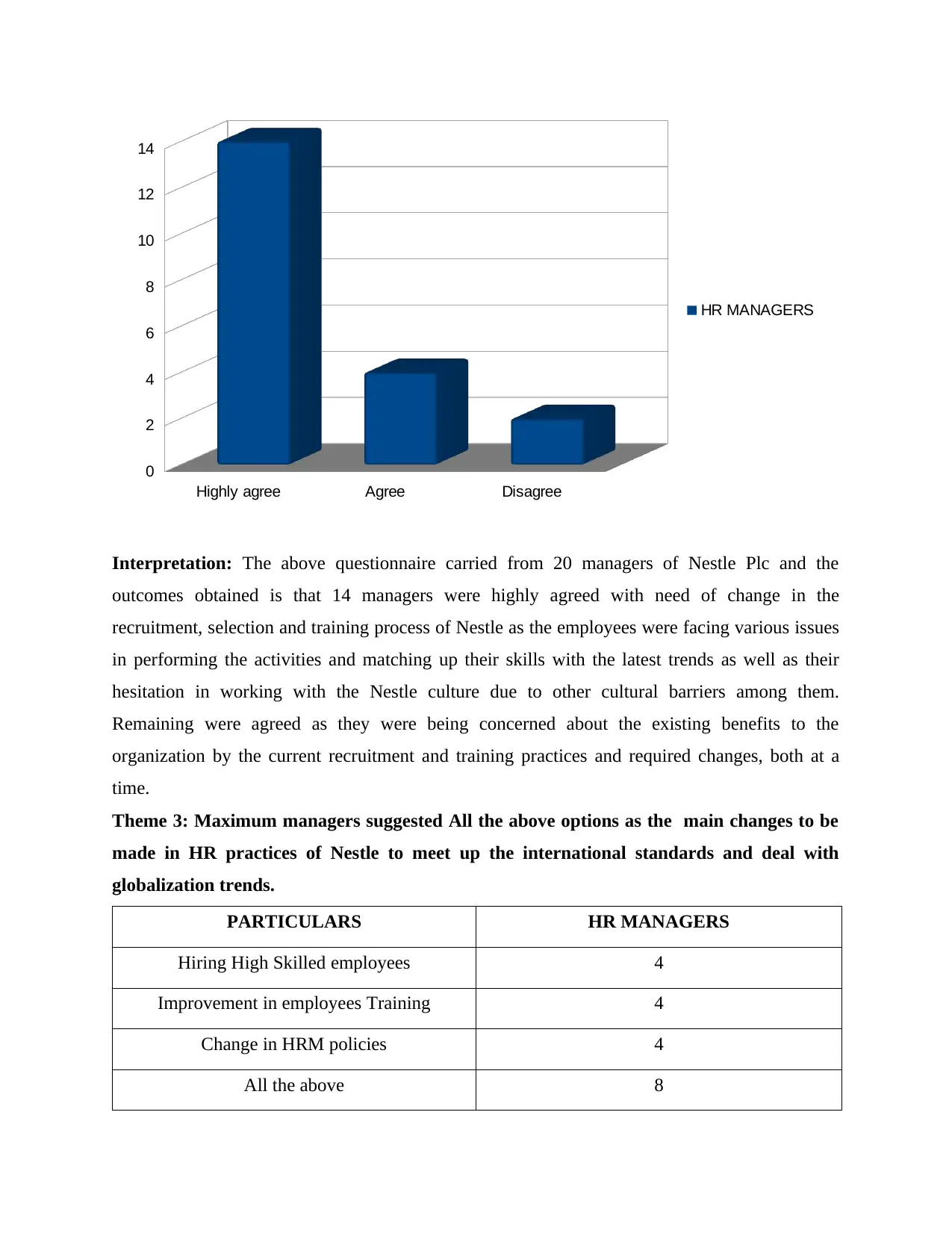
Interpretation: The above questionnaire carried from 20 managers of Nestle Plc and the
outcomes obtained is that 14 managers were highly agreed with need of change in the
recruitment, selection and training process of Nestle as the employees were facing various issues
in performing the activities and matching up their skills with the latest trends as well as their
hesitation in working with the Nestle culture due to other cultural barriers among them.
Remaining were agreed as they were being concerned about the existing benefits to the
organization by the current recruitment and training practices and required changes, both at a
time.
Theme 3: Maximum managers suggested All the above options as the main changes to be
made in HR practices of Nestle to meet up the international standards and deal with
globalization trends.
PARTICULARS HR MANAGERS
Hiring High Skilled employees 4
Improvement in employees Training 4
Change in HRM policies 4
All the above 8
Highly agree Agree Disagree
0
2
4
6
8
10
12
14
HR MANAGERS
outcomes obtained is that 14 managers were highly agreed with need of change in the
recruitment, selection and training process of Nestle as the employees were facing various issues
in performing the activities and matching up their skills with the latest trends as well as their
hesitation in working with the Nestle culture due to other cultural barriers among them.
Remaining were agreed as they were being concerned about the existing benefits to the
organization by the current recruitment and training practices and required changes, both at a
time.
Theme 3: Maximum managers suggested All the above options as the main changes to be
made in HR practices of Nestle to meet up the international standards and deal with
globalization trends.
PARTICULARS HR MANAGERS
Hiring High Skilled employees 4
Improvement in employees Training 4
Change in HRM policies 4
All the above 8
Highly agree Agree Disagree
0
2
4
6
8
10
12
14
HR MANAGERS

Interpretation: The above questionnaire carried from 20 managers of Nestle Plc and the
outcomes obtained is that maximum managers went up with all the above option as the required
changes to be made with the in HR practices of Nestle to meet up the international standards and
deal up with the globalization trends. They justified their statement by stating that Hiring skilled
employees will establish a strong workforce to cope up with the changes and latest trends of
globalization on business, Improving the training process of employees can make them capable
enough to resist the changes and adapt them accordingly and change in HRM policies of the
company will turn up to meet the international standards as well. Remaining opted for single
options as they were concerned of their benefits prior to all of them.
Theme 4: Language barriers in training programs is the main issue and challenge faced by
Nestle in its recruitment and training process due to labour migration across different
countries.
PARTICULARS HR MANAGERS
Corporate cultural differences 6
Change in employment policies 4
Hiring High Skilled employees
Improvement in employees Training
Change in HRM policies
All the above
0%
20%
40%
60%
80%
100%
HR MANAGERS
outcomes obtained is that maximum managers went up with all the above option as the required
changes to be made with the in HR practices of Nestle to meet up the international standards and
deal up with the globalization trends. They justified their statement by stating that Hiring skilled
employees will establish a strong workforce to cope up with the changes and latest trends of
globalization on business, Improving the training process of employees can make them capable
enough to resist the changes and adapt them accordingly and change in HRM policies of the
company will turn up to meet the international standards as well. Remaining opted for single
options as they were concerned of their benefits prior to all of them.
Theme 4: Language barriers in training programs is the main issue and challenge faced by
Nestle in its recruitment and training process due to labour migration across different
countries.
PARTICULARS HR MANAGERS
Corporate cultural differences 6
Change in employment policies 4
Hiring High Skilled employees
Improvement in employees Training
Change in HRM policies
All the above
0%
20%
40%
60%
80%
100%
HR MANAGERS
⊘ This is a preview!⊘
Do you want full access?
Subscribe today to unlock all pages.

Trusted by 1+ million students worldwide
1 out of 24
Related Documents
Your All-in-One AI-Powered Toolkit for Academic Success.
+13062052269
info@desklib.com
Available 24*7 on WhatsApp / Email
![[object Object]](/_next/static/media/star-bottom.7253800d.svg)
Unlock your academic potential
Copyright © 2020–2025 A2Z Services. All Rights Reserved. Developed and managed by ZUCOL.





